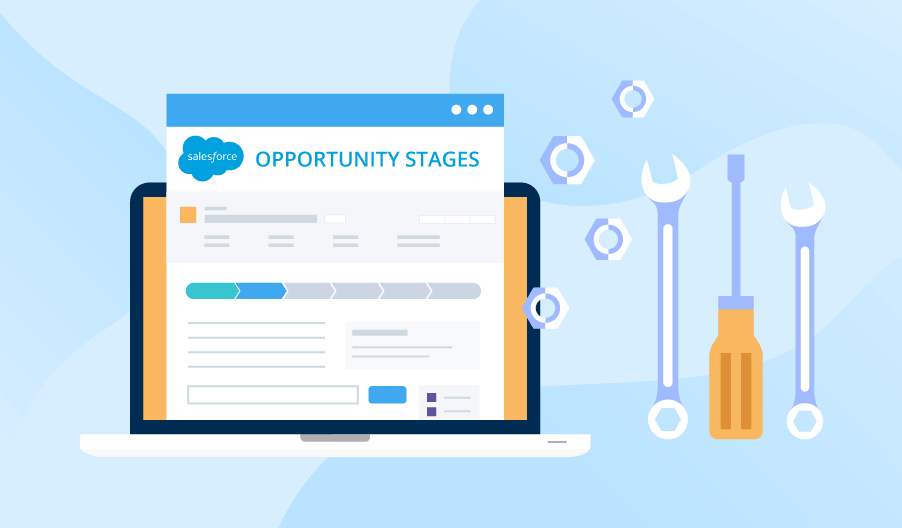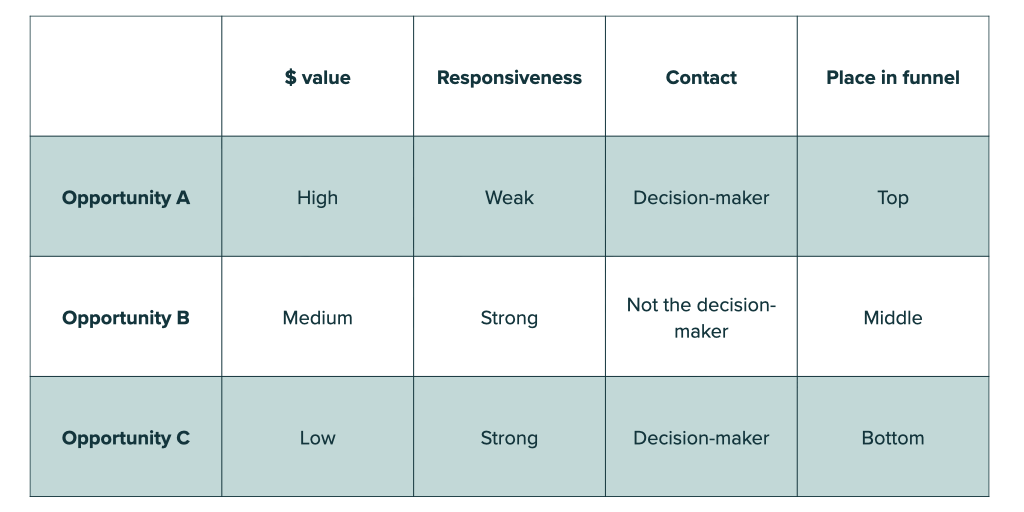What is Opportunity Management?
Dec. 19, 2022 · 7 minutes
Opportunity management, often known as pipeline management, is the process of structuring and tracking your sales pipeline's deals. This helps you prioritize the most likely to close offers and strengthens your sales approach, allowing you to reach your sales objectives.
Consider opportunity management as party preparation. And not just any party, but the greatest party ever. To do this, you must ensure that each and every attendee is completely delighted with their experience.
Obviously, not everyone you invite will attend. To organize and execute the best party ever, you would need a system like opportunity management to assess which invitees are most likely to go, what their likes and dislikes are, and how you can continue to entice them so they don't lose interest. Using this information, it is plausible that you may host an unforgettable party.
Currently, pipeline management is likely best suited for sales—not event planning. However, you get the idea. By having a deeper understanding of who is most likely to convert and evaluating the vast amount of data you collect from every interaction with them, you can devise a strategy to create an exceptional customer experience that fosters brand loyalty and increases profitability.
5 signals you need opportunity management
If you are unsure as to whether this process is required for your firm, the following five signs clearly indicate the need for an opportunity management system.
- It is challenging to discern which opportunities should be prioritized.
- At any given time, you do not know the value of your sales opportunities.
- You are unaware of the ratio of lost opportunities to winning opportunities.
- Opportunities travel slowly down the funnel, with huge gaps between touchpoints frequently occurring.
- You spend considerable time determining the next actions.
Opportunity management eliminates all of these problems. Consequently, firms utilizing an opportunity management system manage account planning and sales cycles with significantly improved speed and efficiency.
Although opportunity management encompasses a large scope, it is a simple procedure to manage if you have the proper tools.
How to manage a pipeline of opportunities?
Let's first examine an opportunity pipeline: It is a device that allows you to track prospective deals throughout the sales process. By glancing through your opportunity pipeline, you should have a clear understanding of the amount and value of potential sales and earnings. This allows you to assess what day-to-day actions you need to schedule and how near you are to achieving your sales targets.
Initially, it is difficult to estimate the potential worth of a lead. When a lead initially enters your sales funnel, you are unsure of the opportunity they represent. As consumers learn more about your brand and goods, however, they qualify as an opportunity; that is, you get sufficient knowledge to determine the potential worth of that sales transaction.
A pipeline helps you to track the progression of qualifying data discovery. In addition, it allows you to keep track of the activities required to obtain this information and the anticipated value of each potential agreement.
You might use a spreadsheet to manage your pipeline and manually track each individual as they progress through your sales funnel. However, such a feat would involve considerable time and effort. In addition, manual data entry is frequently riddled with inaccuracies. This is why many firms opt to employ a CRM software platform for opportunity management.
The digitization of the opportunity pipeline simplifies the tracking of opportunities. It decreases the time, effort, and number of errors involved with manual data entry. In addition, numerous pipeline software applications generate graphical pipelines to make the information easier to comprehend; the majority of people prefer these to a wall of text-filled cells.

Opportunity management process flow
Like any other business process, opportunity management has a flow. And when it comes to flow, the most important aspects are dependability and consistency.
A trustworthy opportunity management process flow is supported by data. In terms of interpersonal interactions, gut instinct is a valuable asset. But when it comes to streamlining a process, you need hard data to support your conclusions. Reporting and analytics will do wonders for revealing what works and what doesn't, allowing you to eliminate acts that impede growth.
A repeatable opportunity management process flow is only achievable if current actions are tracked and recorded. This is where a sales CRM is really useful. Having all of your data, documents, and communications on a single platform enables you to understand precisely what you've done in the past and how you did it. As a result, you can construct a clearly defined step-by-step procedure that you can execute repeatedly and adapt when the data indicates an opportunity.
6 opportunity management best practices
Each company runs differently. But there are a few general guidelines that may be implemented to effectively manage your opportunity pipeline.
1. Research your leads
Despite the fact that lead management and opportunity management are distinct, both begin with the lead. Once a prospect enters your sales funnel, you should gather pertinent information about them, including:
- How much is their budget?
- What is their role inside the organization?
- How rapidly do they react?
- Who makes decisions in their organization?
- How does their purchasing procedure work?
- Who was their most recent provider or vendor, if any?
It is doubtful that you will have all of this information at the outset, but it is essential to gather it. It will indicate whether a lead represents an opportunity or is simply browsing.
2. Establish steps for each discovery
As you discover more about your leads and as they learn more about your company, they advance through the pipeline. It is similar to a board game. As you move your game pieces toward the finish line, they experience various obstacles or duties.
Each stage should be well defined in order to bring sales possibilities closer. For example, you may have a step titled "Identify the decision-makers." This is the next action for the sales team to take before moving on to the other pieces on the game board. Once you get the name of the decision-maker for a particular opportunity, you proceed to the next phase, and so on, until the sale is closed.
3. Focus your efforts where they'll be most effective.
Every prospective opportunity has worth for your firm. It may make sense to prioritize possibilities with the highest value, but value is not limited to monetary terms. There are additional considerations that can help select which opportunity to pursue.
Imagine you have three sales leads in your pipeline. Here is a breakdown of a few of the considerations that can assist you in deciding which to prioritize:

Based on the preceding data, which opportunity would you prioritize first? Without more information, you would have to rely on your gut feeling to make a judgment. The issue with gut instinct is that it is not always trustworthy.
The difficulty with having more information is that you must examine it. And evaluating massive amounts of data can consume many productive hours.
In this case, opportunity management tools are useful. The data-processing capacity of these systems enables you to prioritize prospects so that you may devote more time to chasing them.
4. Automate repetitious processes
Your sales cycle will be accelerated if you automate aspects of your opportunity management process. Pipeline software and other platforms generally include automation technologies that eliminate mundane, repetitive tasks.
Here are some instances of automating opportunity management to expedite the process:
- Send automated follow-up emails to leads
- Automate sales prospecting duties for instantaneous information discovery
- Apps that automate the scheduling of sales meetings
- Pipeline functions that shift opportunities automatically from one step to the next.
There are numerous methods for automating your opportunity pipeline. The goal is to delegate the most time-consuming duties to the software so that you can focus on your leads and their particular demands.
5. Don't disappear from the radar
Today's consumers are extremely busy. Therefore, the optimal time to contact them is when you know they are already considering you. Respond promptly to leads, and whenever an opportunity reaches a new stage, take action without delay.
Even if you believe a lead will stick around, don't lose track of them; every period of absence is an opportunity for them to research alternatives. Establishing a clear sequence of processes and automating duties can allow you to keep on top of communications with prospective customers, even if you have a million other things to do.
6. Monitor your progress
Utilize your CRM to assess the efficacy of your opportunity management procedure. The data might disclose a great deal about your clients and sales cycle. Consequently, you are in a better position to strategize future productive activities.
Implementing an opportunity pipeline will not instantly result in more closed deals. The trick is to integrate it seamlessly into your process, then monitor, strategize, and modify your approach quarterly. Eventually, patterns will emerge that provide a deeper understanding of the direct relationship between your activities and the consequences.
Consider that the tools you employ, such as your contact management software, will play a significant role in how you monitor and analyze opportunities. A simple user interface is essential for making the process more natural and, as a result, increasing the possibility that it will have a positive influence on productivity.
Contact Us
Contact Info
Address
Maslak Mahallesi, Büyükdere Caddesi, Nurol Plaza 255 B02 Sarıyer, Istanbul, Turkiye
Phone